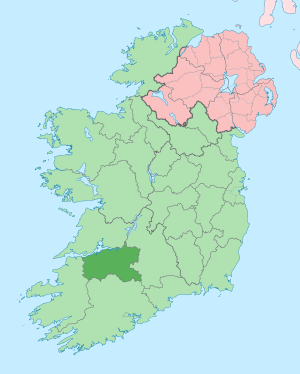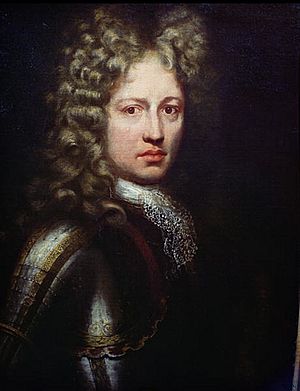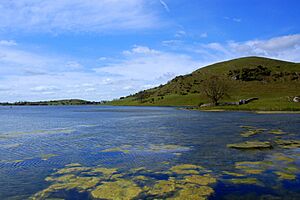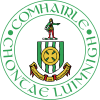County Limerick facts for kids
Quick facts for kids
County Limerick
Contae Luimnigh
|
||
|---|---|---|
|
||
| Nickname(s):
The Treaty County, Shannonside
|
||
| Motto(s):
Irish: Cuimhnigh ar Luimneach
"Remember Limerick" |
||
 |
||
| Country | Ireland | |
| Province | Munster | |
| Region | Southern (Mid-West) | |
| Established | 1210 | |
| County town | Limerick and Newcastle West | |
| Area | ||
| • Total | 2,756 km2 (1,064 sq mi) | |
| Area rank | 10th | |
| Highest elevation | 918 m (3,012 ft) | |
| Population
(2022)
|
209,536 | |
| • Rank | 9th | |
| • Density | 76.03/km2 (196.9/sq mi) | |
| Demonym(s) | Limerickman, Shannonsider, Treatyman | |
| Time zone | UTC±0 (WET) | |
| • Summer (DST) | UTC+1 (IST) | |
| Eircode routing keys |
V35, V42, V94 (primarily)
|
|
| Telephone area codes | 061, 069 (primarily) | |
| Vehicle index mark code |
L (since 2014) LK (1987–2013) |
|
County Limerick (Irish: Contae Luimnigh) is a county in the west of Ireland. It is part of the Munster province. The county is named after Limerick city. Limerick City and County Council is the local government for the area. In 2022, about 209,536 people lived here. About half of them lived in Limerick City, which is the county capital.
Contents
Geography of County Limerick
Limerick shares borders with four other counties. To the west is Kerry. To the north is Clare. Tipperary is to the east, and Cork is to the south. Limerick is the fifth largest county in Munster by size. It is the second largest by population.
The River Shannon flows through Limerick city. It then goes into the Atlantic Ocean. This part of the river is called the Shannon Estuary. The estuary is not very deep. So, the main port for the county is at Foynes. This is a few kilometers west of the city.
Limerick City is the main town. It is also Ireland's third-largest city. Other important towns in the county include Newcastle West, Kilmallock, and Abbeyfeale.
Most Populous Towns
Limerick City is the county town. It is shown in bold below.
| Rank | Change since 2016 |
Town | Population (Census 2022) |
Increase since 2016 |
|---|---|---|---|---|
| 1 | Limerick | 102,287 | 1.4% | |
| 2 | Newcastle West | 7,209 | 1.4% | |
| 3 | Annacotty | 3,398 | 2.5% | |
| 4 | Castleconnell | 2,488 | 2.8% | |
| 5 | Abbeyfeale | 2,206 | 1.5% | |
| 6 | Kilmallock | 1,761 | 0.92% | |
| 7 | Caherconlish | 1,569 | 1% | |
| 8 | Murroe | 1,432 | 0.66% | |
| 9 | Croom | 1,240 | 1.1% | |
| 10 | Rathkeale | 1,231 | -7.03% | |
| 11 | Askeaton | 1,236 | 1.4% | |
| 12 | Adare | 1,224 | 1.4% |
Physical Landscape

The name Luimneach in Irish might mean "the flat area." This fits well because much of the county is a fertile plain. Mountains surround the county. These include the Slieve Felim Mountains to the northeast. The Galtee Mountains are to the southeast. The Ballyhoura Mountains are to the south. The Mullaghareirk Mountains are to the southwest and west.
The highest point in the county is Galtymore (919 meters). It is in the southeast corner. This mountain separates Limerick from County Tipperary. Limerick shares the title of the 3rd-highest county peak in Ireland with Tipperary.
The eastern part of the county is known as the Golden Vale. This area has rolling low hills. It is famous for its dairy farms. Towards the west, the Mullaghareirk Mountains offer great views.
Several rivers flow through the county into the Shannon. These include the Mulcair, Maigue, Deel, and Feale.
History of County Limerick
People lived in the Lough Gur area as early as 3000 BC. Ancient stone structures called megaliths from 3500 BC have been found at Duntryleague. Around 400 BC, the Celts arrived. They divided the county into small kingdoms.
From the 4th to the 11th century, the Uí Fidgenti kingdom covered most of County Limerick. The Danes set up Limerick as a town in the mid-900s. They often fought with other Irish families.
King John's Castle was built in Limerick around 1200. New families, like the FitzGeralds, were given land. This changed who had power in the area. The Uí Fidgenti still made up a large part of the population. Their main fort was at Bruree, near the River Maigue.
St. Patrick brought Christianity to Limerick in the 5th century. Important monasteries were built at Ardpatrick and Mungret. A famous treasure, The Ardagh Chalice, was found in a fort in west Limerick in 1868. It is a beautiful piece of metalwork.
The Vikings arrived in the 9th century. They founded Limerick city on an island in the River Shannon in 922. In 1210, County Limerick was officially formed. Over time, the Normans who came to Ireland became very much like the Irish.
The English rulers wanted more control. They sent English settlers to the county. This led to a revolt in 1569, called the Desmond Rebellions. This war caused a lot of damage. The lands of Irish families were taken away.

The county faced more wars in the next century. During the Cromwellian conquest of Ireland in the 1650s, Limerick city was under siege for a year. It finally surrendered in 1651.
Later, during the Williamite War in Ireland (1689–1691), the city was besieged two more times. In 1690, General Patrick Sarsfield famously destroyed the enemy's cannons at Ballyneety. The Irish supported the Jacobite side. After the second siege, the Treaty of Limerick was signed. This treaty was good for the Irish. However, the English later broke its promises. Because of this, Limerick became known as the "City of the Broken Treaty."
The 18th and 19th centuries were hard for many people. The Great Famine in the 1840s caused many people to leave Ireland. The Irish language also became less common. Things started to get better around the early 1900s. Farmers could finally buy their own land.
Limerick saw a lot of fighting during the Irish War of Independence (1919–1921). The Irish Civil War that followed also had fierce battles, especially in Limerick city.
Irish Language
There are 2,322 Irish speakers in County Limerick. They attend six gaelscoileanna (Irish language primary schools). There are also three gaelcholáistí (Irish language secondary schools).
Culture and Arts
In 2014, Limerick was Ireland's first National City of Culture. Many art and cultural events happened all over the city. The Limerick City Gallery of Art shows modern art. Theatres include the Limetree Theatre and the University Concert Hall.
Limerick has a lively music scene. Famous bands like The Cranberries started here. The city is also home to comedians like The Rubberbandits. The famous actor Richard Harris was from Limerick.
The city is the setting for Frank McCourt's book Angela's Ashes. A "limerick" is a funny five-line poem. Its name might come from Limerick city or county.
Riverfest is a yearly summer festival in Limerick. Other festivals include the Knights of Westfest in Newcastle West. Fleadh by the Feale is in Abbeyfeale. The west of the county is known for its traditional Irish music.
Places to Visit


- Adare
- Adare Manor
- Castle Oliver
- Clare Glens
- Croom Castle
- Curraghchase Forest Park
- Foynes Flying Boat Museum
- Glenstal Abbey
- Glin-Estuary Drive
- Glin Castle
- Grange Stone Circle
- Hunt Museum
- King John's Castle
- Limerick City Museum
- Lough Gur
- The Treaty Stone
Transportation
Rail Travel
The main train station in Limerick is Colbert station. It is named after Con Colbert, a man from West Limerick. He was executed after the Easter Rising in 1916.
Limerick has three active train lines:
- The Limerick–Ballybrophy railway line goes to North Tipperary.
- The Ennis line goes through County Clare to Galway.
- The Limerick Junction line is the busiest. It connects Limerick to the Cork–Dublin line. It also connects to the Limerick Junction–Clonmel–Waterford line.
There is also a line to Foynes, but it has not been used for passengers since 2000.
Roads and Buses
The M7 is the main road from Limerick to Dublin. The M/N20 connects the county to Cork. The N21 road links Limerick to Tralee. It passes through towns like Adare and Newcastle West.
The N/M18 road links the county to Ennis and Galway. The N24 goes southeast towards Waterford. The N69 travels along the Shannon Estuary. It connects the Port of Foynes with Limerick city.
The county's main bus station is next to Colbert Station. It connects most parts of the city and county.
Air Travel
County Limerick does not have its own commercial airport. However, Shannon Airport is only 25 km away in County Clare. It has many flights to Europe and North America. Some people in the south of the county might also use Kerry Airport or Cork Airport.
Foynes, a village in the west, played a special role in aviation history. In the 1930s and 1940s, land planes could not fly across the Atlantic Ocean. So, seaplanes were used. Foynes was the last stop on the eastern side for these planes. It became one of Europe's biggest civilian airports during World War II.
The first transatlantic flights from Foynes happened in 1937. Services to New York and other cities followed. This changed when Shannon Airport opened in 1942. The Foynes flying-boat station closed in 1946.
Sea Travel
The port of Limerick was once near King's Island. Today, it is further down the Shannon River. The Shannon Foynes Port Company (SFPC) runs all sea activities in the Shannon estuary. It is a general port facility.
Foynes is the main deepwater commercial port. SFPC is the second largest port in Ireland. It handles over 10 million tonnes of cargo each year.
Sports in Limerick
Rugby union is very popular in the county. Some of Ireland's most famous teams are in Limerick city. These include Garryowen and Shannon. Thomond Park is the home of the Munster Rugby team. They have many fans throughout the county.
Gaelic Athletic Association (GAA) games are popular outside the city. Hurling is big in east, mid, and south Limerick. The Limerick GAA board plays its home games at the Gaelic Grounds in the city. The county hurling team has won the All-Ireland Senior Hurling Championship twelve times. Their last win was in 2023. They have also won many Munster Championships and National Hurling Leagues.
Gaelic football is more popular in west Limerick. It is also strong in the southeast and on the eastern edges of the city. Limerick was a strong football team in the early days of the GAA. However, hurling became more popular in the 20th century. Limerick's last win in the All-Ireland Senior Football Championship was in 1896. But in recent years, the football team has improved.
Treaty United plays in the FAI First Division, which is Ireland's second soccer league. The club has won the Premier Division twice. They have also won the FAI Cup twice. They play at the Markets Field.
Limerick city also has one of Ireland's two 50-meter swimming pools. It is at the University of Limerick Sports Arena. The UL Eagles are one of Ireland's top basketball teams. They play in the Irish Premier League.
Andy Lee, a WBO World Middleweight boxing Champion, is from Limerick. He won his world title in 2014. He was the first Irishman to win a world title in America since 1934.
Media
Radio and TV
RTÉ Lyric FM is a national classical music radio station. It broadcasts from studios in Limerick city centre. Limerick's local radio station is Live 95FM. Spin Southwest broadcasts to several counties from its studios in Raheen. West Limerick 102 is a community station for the west of the county.
Newspapers
The two main newspapers for the city and county are the Limerick Leader and the free Limerick Post. The Limerick Leader has different editions for the city and county. The Limerick Chronicle is mainly a city paper. The Weekly Observer covers the western half of the county. The Vale Star covers South Limerick and North Cork.
Anthem
The song "Limerick You're a Lady" is often linked with the county. You might hear it at sports events. "Seán South from Garryowen" is another popular Limerick song. It tells the story of Sean South, an IRA member from Limerick. He was killed in 1957.
Images for kids
See also
 In Spanish: Condado de Limerick para niños
In Spanish: Condado de Limerick para niños








